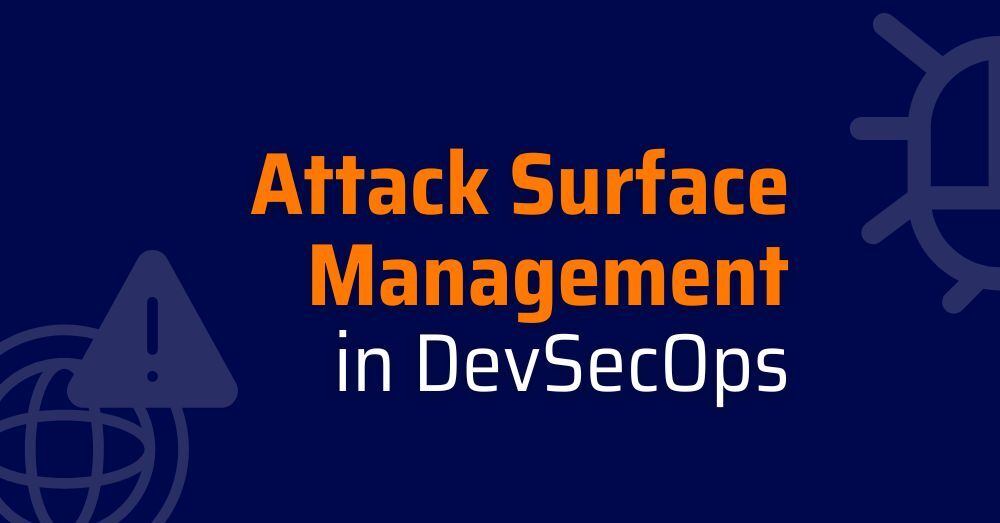Most teams think of attack surface management as scanning the visible attack surface, exposed domains, open ports, and misconfigured services. That is the traditional scope of external attack surface management. However, in modern DevSecOps, the real risks live deeper: in code, dependencies, and pipelines. For example, our post on A Deep Dive into CI/CD Pipelines Vulnerabilities explains how poisoned pipelines expand the attack surface.
In this guide, we explain attack surface management, show why the perimeter view is incomplete, and highlight how developers can shrink their attack surface across the entire software lifecycle. Moreover, we touch on how attack surface analysis complements this by extending visibility into pipelines and code.
What Is Attack Surface Management?
In simple terms, attack surface management (ASM) is the process of discovering, monitoring, and reducing everything an attacker could exploit. The attack surface is not only public-facing servers but also:
- APIs and hidden endpoints
- Open-source dependencies
- Secrets in repositories or IaC files
- CI/CD pipelines and workflows
Traditionally, attack surface management focused only on external assets such as IP ranges, DNS records, or cloud buckets. However, limiting it to what’s public leaves gaps. Modern external attack surface management tools cannot see insecure IaC templates, vulnerable packages, or embedded secrets, yet those exposures expand the attack surface every day.
👉 For reference, see CISA guidance on Cyber Asset Attack Surface Management and NIST’s paper on managing the attack surface.
Why the Classic Approach Falls Short
Classic tools provide value: they find forgotten subdomains, detect open ports, and highlight risky cloud services. Nevertheless, this external view is useful but limited.
Modern software delivery introduces hidden risks that expand the attack surface:
- Vulnerable open-source dependencies with known CVEs
- Misconfigured Terraform or Kubernetes files exposing unnecessary services
- Secrets left in
docker-compose.ymlor Git history - Unsafe GitHub Actions or Jenkins jobs attackers can hijack
Risky Code Example (Kubernetes manifest):
# Risky Kubernetes manifest
apiVersion: v1
kind: Pod
metadata:
name: insecure-pod
spec:
containers:
- name: nginx
image: nginx:latest
securityContext:
privileged: true # 🚨 Dangerous: runs container as root
Even this small misconfiguration widens the attack surface. If compromised, the attacker gains root on the host node.
Threat Actor Example:
Attackers often scan public Git repos. For example, a leaked AWS key inside docker-compose.yml can let them log into your cloud account, deploy malware, or exfiltrate sensitive data.
Expanding Coverage to Code and Pipelines
Here’s how teams can extend attack surface management into the SDLC:
- Dependencies: Vulnerable libraries increase the attack surface, even when networks look secure.
- Infrastructure as Code: Unsafe templates create new entry points.
- Secrets: Hardcoded tokens instantly widen the attack surface if leaked.
- CI/CD Pipelines: Compromised workflows can hand over the build process to attackers.
“In short, external attack surface management maps what’s outside. Meanwhile, a complete approach also covers internal code and pipelines. This broader view is closely tied to the future of supply chain security, as we discuss in The Road Ahead: Predictions for SSCS in DevOps.
Comparison: Perimeter ASM vs Full Attack Surface Management
| Aspect | Perimeter ASM (External) | Attack Surface Management (Modern) | Why It Matters |
|---|---|---|---|
| Visibility | Public attack surface only | Internal + external attack surface | A complete view finds risks traditional tools miss. |
| Risks Detected | Subdomains, open services | Vulnerable libraries, secrets, IaC misconfigs | Internal risks are prime targets for supply chain attacks. |
| DevSecOps Relevance | Focus on ops & IT | Directly tied to developer workflows | Shifts security left into code and pipelines. |
| Prevention | Patch exposed assets | Shrink attack surface end-to-end with guardrails | Faster fixes cut costs and prevent production outages. |
How Xygeni Strengthens Attack Surface Management
Xygeni extends beyond external attack surface management with full-stack coverage. In fact, it adds protection across every layer of the SDLC:
- SAST and SCA: Detect exploitable flaws in code and dependencies.
- Secrets Security: Identify, revoke, and auto-remediate exposed credentials.
- IaC Scanning: Catch insecure Terraform, Kubernetes, and Docker configs.
- CI/CD Security: Block unsafe workflows and enforce guardrails in pipelines.
- ASPM Platform: Provide unified visibility across repos, builds, and artifacts.
With this approach, attack surface management is not just about monitoring domains — it reduces the attack surface across the entire DevSecOps lifecycle. Moreover, it connects directly with modern ASPM practices, as detailed in our post Beyond Vulnerability Management: The Expanding Horizons of ASPM.
What You’ll Get With a Free Trial
- Instant scan of repos and pipelines
- Clear map of internal + external attack surface
- Guardrails that block risky merges automatically
Therefore, Start a free trial of Xygeni and get a complete, end-to-end view of your attack surface in minutes. In addition, see exactly where your code, pipelines, and infrastructure are exposed, before attackers find them.
Conclusion
In conclusion, if you only focus on perimeter assets, your attack surface management is incomplete. True DevSecOps requires managing the full attack surface: external exposure plus risks in code, dependencies, and pipelines.
Moreover, with Xygeni, teams can go beyond external attack surface management. They don’t just monitor the perimeter, instead, they shrink the attack surface everywhere software is built and delivered.
FAQs on Attack Surface Management
What attack surface is protected by NAC?
Network Access Control (NAC) protects the network-level attack surface by controlling which devices and users can connect. However, it reduces exposure only from rogue devices and does not address risks in code, dependencies, or CI/CD pipelines. Therefore, NAC should be seen as just one layer of protection.
What is another name for attack surface?
An attack surface is sometimes called a “digital footprint” or “exposure area.” In addition, in DevSecOps this footprint includes not just servers but also APIs, repositories, dependencies, and pipeline configurations.
What is the attack surface of social engineering?
In social engineering, the attack surface is human, not technical. It includes employees, contractors, and partners who may be tricked into sharing access or sensitive data. Moreover, training, phishing simulations, and MFA significantly reduce this type of exposure.
What is external attack surface management?
External attack surface management (EASM) discovers and monitors everything visible from the internet: domains, IPs, ports, cloud storage, and SaaS exposures. However, while useful, EASM does not cover internal risks like IaC misconfigs, secrets in repos, or unsafe CI/CD pipelines. As a result, it should be combined with modern internal scanning.
What is attack surface in cyber security?
In cyber security, the attack surface is every possible entry point an attacker could exploit: from network services to source code, third-party libraries, and user accounts. In fact, managing it means continuously finding and reducing those exposures to minimize risk.
How are attack vectors and attack surfaces related?
The attack surface is the set of possible entry points. An attack vector is the specific path an attacker uses to exploit one of them. For example, a leaked API key widens the attack surface, while credential stuffing against that API is the attack vector. Therefore, reducing the surface directly limits the available vectors.
What is attack surface monitoring?
Attack surface monitoring is the continuous process of watching for new exposures, like a newly opened port, a leaked secret, or a dependency update that introduces vulnerabilities. Moreover, it is a key part of modern attack surface management because threats evolve constantly.

